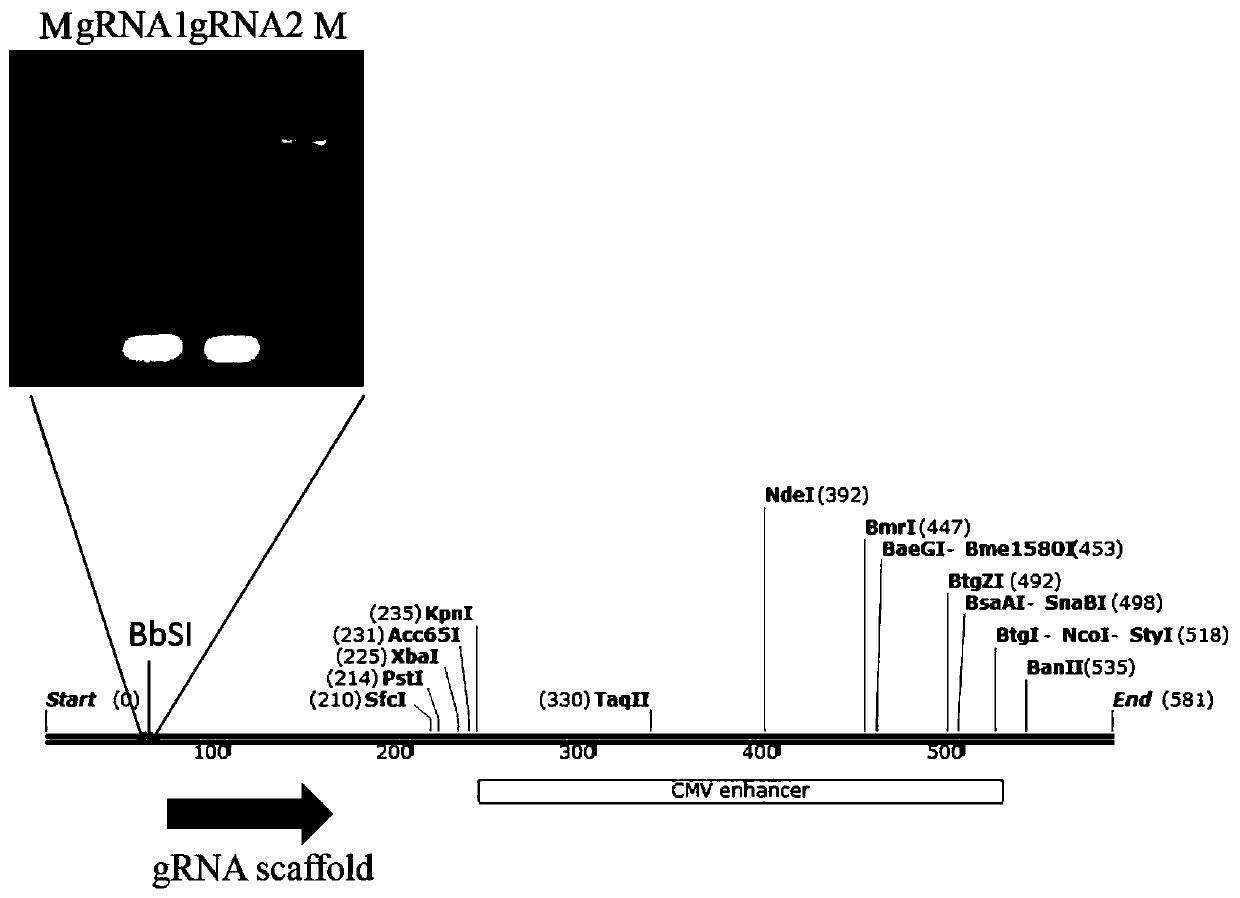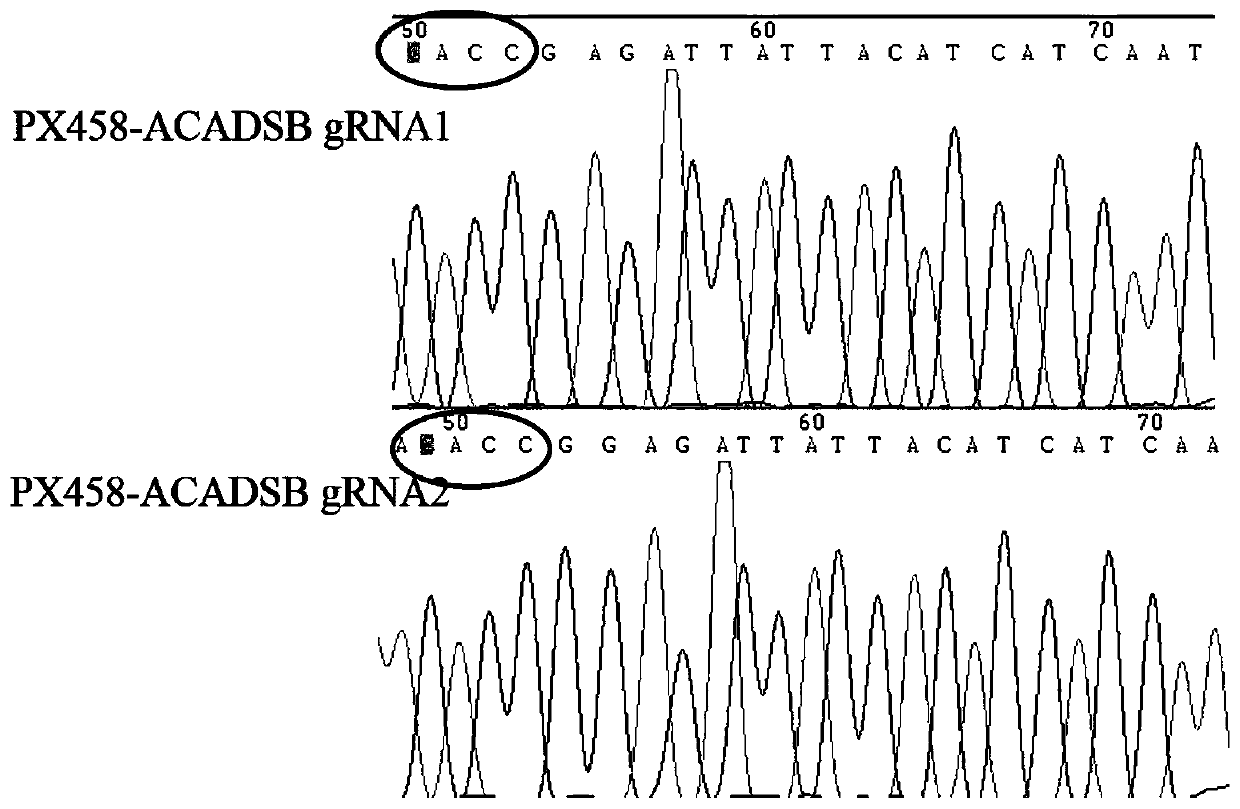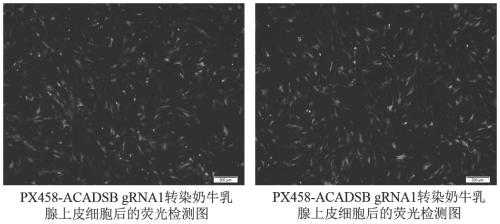A cow mammary gland epithelial cell line knocked out of acadsb gene and its construction method
A breast epithelial cell and gene technology, applied in the field of genetic engineering, can solve problems such as unstable inheritance and siRNA interference
- Summary
- Abstract
- Description
- Claims
- Application Information
AI Technical Summary
Problems solved by technology
Method used
Image
Examples
Embodiment 1
[0039] Example 1 ACADSB gene knockout target site setting, sgRNA design
[0040] First, determine the position of the conserved domain of the ACADSB (ENSBTAT00000024017.2) gene protein to better ensure the knockout effect. The target sequence to be knocked out is designed in the corresponding coding region, that is, the fifth exon of the ACADSB gene, and sgRNA is designed, and two pairs of recognition sequences (sgRNA) are designed, as follows,
[0041] ACADSB gRNA1:GAGATTATTACATCATCAAT GGG (SEQ ID NO: 1);
[0042] ACADSB gRNA2: GGAGATTATTACATCATCAATGG (SEQ ID NO: 2).
[0043] Design DNA oligos to synthesize double-stranded gRNA, and its specific primer sequences are as follows:
[0044]ACADSB gRNA1F: CACCGAGATTATTACATCATCAAT (SEQ ID NO: 3);
[0045] ACADSB gRNA1R: AAACATTGATGATGTAATAATCTC (SEQ ID NO: 4);
[0046] ACADSB gRNA2F: CACCGGAGATTATTACATCATCAA (SEQ ID NO: 5);
[0047] ACADSB gRNA2R: AAACTTGATGATGTAATAATCTCC (SEQ ID NO: 6).
[0048] ACADSB detection primer F: 5'...
Embodiment 2
[0050] Example 2 Construction of gRNA expression vector
[0051] 1. Experimental method
[0052] Anneal the forward and reverse single-stranded oligonucleotide sequences to obtain a double-stranded oligonucleotide fragment, and connect it with the PX458 vector that was digested by BBSI and linearized to obtain a recombinant plasmid, denoted as PX458-ACADSB gRNA1 and PX458-ACADSB gRNA2.
[0053] The specific operation is as follows:
[0054] (1) After gRNA synthesis, use ddH 2 The primers (SEQ ID NO: 3-6) were dissolved in O water to 100 μM, and the single-stranded oligonucleotides were annealed to obtain double-stranded oligonucleotides.
[0055] Annealing reaction system: add 1 μL each of the upstream and downstream primers, ddH 2 O 43 μL, NEB buffer (10x) 5 μL.
[0056] Annealing reaction conditions: React at 95°C for 10 minutes on a PCR instrument, then gradually lower the temperature at a rate of 5°C / min until the temperature drops to 25°C. The annealed primers were ...
Embodiment 3
[0066] Construction of Example 3 Knockout Cell Lines
[0067] The recombinant plasmid was transiently transfected into cow mammary gland epithelial cells, a single positive cell expressing green fluorescent protein was screened by flow cytometry, and the positive cell line of ACADSB gene knockout was obtained by expanding culture.
[0068] 1. Experimental method
[0069] (1) Transfection of cell lines
[0070] The dairy cow mammary gland epithelial cell line constructed earlier by the research group was used as the research object, and the cells were cultured in a 6-well plate, and replaced with fresh DMEM / F12 medium (without resistance) containing 10% FBS, until the confluence of the cells reached 70 Transfection started at -80%.
[0071] Dilute 3 μg of the recombinant plasmid and 6 μL of Fugene HD transfection reagent into 200 μL of opti-MEM, mix gently, and after standing for 20 minutes, gently add dropwise to the cells that have been changed to DMEM / F12 basal medium in a...
PUM
 Login to View More
Login to View More Abstract
Description
Claims
Application Information
 Login to View More
Login to View More - R&D
- Intellectual Property
- Life Sciences
- Materials
- Tech Scout
- Unparalleled Data Quality
- Higher Quality Content
- 60% Fewer Hallucinations
Browse by: Latest US Patents, China's latest patents, Technical Efficacy Thesaurus, Application Domain, Technology Topic, Popular Technical Reports.
© 2025 PatSnap. All rights reserved.Legal|Privacy policy|Modern Slavery Act Transparency Statement|Sitemap|About US| Contact US: help@patsnap.com



